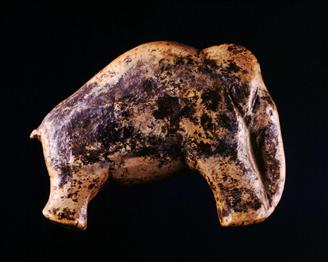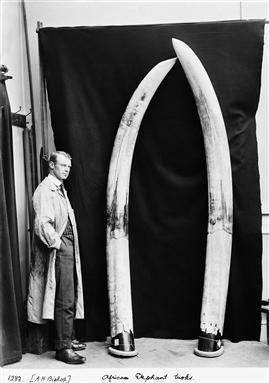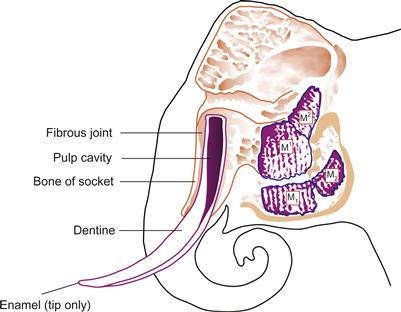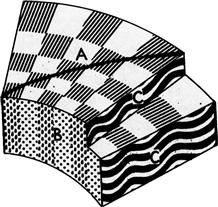2
Tusks and Ivory
The shaman, his face dyed with red ochre, the colour of blood, was ready to commune with the spirits who controlled the outcome of the hunt. He had also drunk the secret potion made from a mixture of plants. He lit his stone lantern from the fire around the entrance and slowly receded into the depths of the cave. The walls crowded in on him. At some points the channel was so narrow that he had to turn sideways to progress. Suddenly he was in a large recess, and there, in the flickering light of his lantern, he saw on the rock face what he had come for, the ancient images of the animals that shared the land with them. Some were simple outlines in black charcoal, others beautifully depicted in reds, browns and yellows, the topography of the cave surface almost making them spring to life. Every type of creature known to him was there, so well represented as to be instantly recognisable. These noble animals shared the land with them and had equal rights to it. However, some animals had to be killed to provide his people with life’s necessities, namely food, clothing, oil for their lanterns and tools. His gaze quickly scrolled over the images of bison, horses, bulls and deer, until it focused on the target of their hunt, the woolly mammoth (Figure 2.1). There it was, near the cave roof, the outline of its body and trunk unmistakable. The shaman knelt down before the image, his thoughts concentrating on the hunt that was soon to follow. In his mind he visualised the hunters, well camouflaged by trees and bushes, slowly following a group of mammoths. They identified an older animal that seemed weaker than the rest and quietly pursued it until they had it surrounded. The bravest and strongest hunter rushed in first and drove his spear into the tough hide, while the others made loud noises to frighten off the rest of the herd. At each opportunity, the hunters drove more and more spears into the wounded mammoth, making sure that it did not escape. Its movements became weaker and weaker until it could no longer stay upright. It collapsed onto the ground. With clubs, they crushed its skull and ended its life. The chase was over and the hunters victorious.

Figure 2.1 Cave painting depicting a mammoth and a cow, from the Chapel of the Mammoths (cave painting), Grotte de Pech Merle, Lot, France/Index/The Bridgeman Art Library.
The shaman came out of his trance, slowly rose to his feet and retraced his steps to the front of the cave. He had been gone for 3 h. The hunters, assured that everything had been done to provide for a successful outcome to their hunt, confidently set off.
A week later the hunters returned, triumphantly carrying meat carved from a woolly mammoth. It was not an old, weakened mammoth that they killed, but a young one that, once they had managed to separate it from its mother, provided an easy kill. Although they left the tusks behind, a few small fragments had broken off and were brought back to present to their shaman. The shaman returned to the depths of the sacred cave to give thanks to the spirits for once more providing them with sustenance.
The shaman kept the small pieces of mammoth tusk close to him. His senses were stirred by the feel of them, and their creamy colour stood out against the drabness of his surroundings. While handling them, he noticed that he could scrape off thin shavings of the tusk with a sharp flint, and that this produced very small changes in shape. One day, while looking at one of the pieces of tusk, he imagined within the small block a figure of the mammoth itself. After months of effort, he had created an exquisite carving of the mammoth, only 4 cm long (Figure 2.2).

Figure 2.2 35,000-year-old carving showing a woolly mammoth from Germany. Made from mammoth ivory, it is the oldest known ivory carving.
Source: Courtesy of Hilde Jensen, University of Tübingen.
The shaman had produced one of the earliest pieces of sculpture in recorded history. It was rediscovered 35,000 years later and created a media sensation. Unwittingly, he also produced an artefact that would endanger the very existence of the type of animal he so much respected and depended upon for food. The material of a mammoth tusk is known to us by another name – ‘ivory’.
What Are Tusks?
Not everyone realises that tusks are actually teeth. They are large, curved teeth that project out from the mouth and are supported by roots that are embedded in the jaw. Because of their size, they are among the most highly specialised forms of teeth. Tusks reach their great size by growing throughout life. In addition to elephants, tusks are found in hippopotami, pigs, walruses and narwhals (a tusked whale) and are larger in the male of the species.
Unlike other teeth, tusks are unusual in that they generally lack a covering of enamel (except for a small amount at the tip in the newly formed tusk). This means a tusk is composed entirely of dentine, apart from a thin covering of cement, which anchors the tusk to the jawbone. The most recognised tusks belong to the elephant, and the dentine of elephant tusks is usually referred to by the more familiar name of ivory. The same name is also given to the dentine forming the smaller tusks of other mammals as well as the teeth of sperm whales. Unfortunately, man covets and prizes the tusks of elephants, and wars have been fought over obtaining them.
Elephant Tusks
Elephant tusks represent their upper incisors, one on each side. In African elephants, they can reach up to 3 m in length, be up to 20 cm thick, and each weigh up to 90 kg (200 lbs) (Figure 2.3). One-third of the tusk lies hidden and embedded within the socket of bone, with the remaining two-thirds being visible on the outside.

Figure 2.3 Illustration showing two very large elephant tusks.
Source: Courtesy of the Natural History Museum, London/Science Photo Library.
Figure 2.4 shows a diagram of an elephant tusk. The embedded part of a tusk has a soft, central pulp cavity surrounded by hard dentine. The pulp cavity is widest at the base of the tooth but gradually narrows and disappears at the margins of the bony socket as it becomes filled in with dentine, which is formed continuously throughout life. A thin, fibrous joint (periodontal ligament) connects the outer layer of cement to the wall of the bony socket. The exposed part of the tusk is solid and has considerable strength and elasticity.

Figure 2.4 Diagram showing the structure of an elephant tusk embedded in the upper jaw. Note that only one pair of grinding molar teeth are ever present on each side of the jaw (labelled M1 in the upper jaw and M1 in the lower jaw). When they are worn down, they are replaced from behind by the next pair of molar teeth (labelled M2 in the upper jaw and M2 in the lower jaw). When the sixth and last molar teeth have been worn down the elephant would die.
The tusks of African elephants are larger than those of Asian elephants. Tusks can grow up to a rate of 3 mm per week, which, coincidentally, is the same as that for incisors in rodents such as the rat. The difference is that rodents continually wear their teeth away as they use them for gnawing, so that the incisor remains more or less the same size throughout life. Rodents also live only for a year or two, compared with 50 years or more for an elephant, which does not wear its tusks away.
The evolution of tusks has given elephants a remarkable tool to aid in their survival. In both African and Asian species, tusks are used in rooting for food and breaking the bark off trees. Together with the trunk, tusks can help uproot whole trees on which the elephant feeds. They are also used as offensive weapons. The strongest male (bull) elephants with the largest tusks obtain dominance over their rivals in the mating season, hence the name tuskers. Baby elephants have very small milk tusks that drop out after the first year, soon to be replaced by the permanent tusks. Elephants may favour using the tusk on one side.
Elephant Ivory
Because of its size, composition and unusual structure, ivory may be cut to various thicknesses, including very thin layers that allow for delicate inlay work. Most importantly, it can be carved very finely and its surface can be polished, revealing a range of colours from white (freshly cut) to yellow (aged). Together with its sensuous feel, these properties appeal to man’s aesthetic nature and, for thousands of years, ivory has been used to produce decoration of all types, from personal ornamentation to works of art, especially religious. In more recent times, ivory provided material for piano keys, cutlery handles and even bagpipe mounts, while its elasticity was highly suited to the manufacture of snooker and billiard balls. Ivory is also an ingredient in some traditional medicines.
Bearing in mind how much ivory in all its forms is in circulation, it is impossible to visualise the vast numbers of elephant tusks needed to supply this demand. Some ivory would have been obtained after the natural death of the elephant, but a large amount, particularly recently, has been obtained following purposeful slaughter. The finest ivory, from African elephants, is more translucent and has a yellower appearance than Asian (Indian) ivory, which is more opaque, whiter and softer.
To understand the properties of ivory, you first need to know a little about its structure. Like other animals, dentine in the elephant tusk is formed by living cells as a composite of organic fibres, which provide the elasticity, and inorganic crystals of calcium phosphate, which give it strength and hardness. Dentine is permeated by millions of minute tubes (dentinal tubules) running from the central pulp outwards towards the surface. Elephant ivory can be distinguished from all other types by the presence of a unique pattern of structural lines. In a cross-section of a tusk, two intercrossing systems of curved lines are seen, referred to as Schreger lines. Superimposed on the lines is a curved, checkerboard arrangement of light and dark squares (Figure 2.5). More detailed microscopic analysis provides an explanation for this appearance (Figure 2.6). The dentine tubules making up the ivory are arranged in small groups, within which the undulating curvatures are all in the same phase but are in the reverse phase from those of adjacent columns. In this manner, the troughs of the waves of one column are opposite the crests of the waves in the adjacent column. The ivory will appear dark or light depending on whether the light rays hit the crests or the troughs. The cross-hatching or checkerboard arrangement will not be seen in ivory cut in other planes, where the ivory may have a simpler, striped appearance. Ivory from extant elephants can be distinguished from extinct mammoths according to the angle of intersection of the Schreger lines, that in the elephant being larger.

Figure 2.5 Transverse section of elephant ivory showing the characteristic checkerboard pattern. Two lines of Schreger have been superimposed, and the angle of their intersection helps to differentiate the type of ivory. In elephant ivory the angle is greater than 115°, while in mammoth ivory the angle is less than 90°.
Source: Courtesy of Dr S. O’Connor, University of Bradford and the Hunterian Museum at the Royal College of Surgeons.

Figure 2.6 Schematic drawing of a block of elephant ivory showing the dentinal tubule pathways. The top surface (A) is a true cross section of the tusk and shows a curve of a Schreger line passing through the dark squares of the checkerboard appearance. (B) indicates the pulpal surface where the dentinal tubules will be seen in cross-section. Part of a column has been removed from the radial surface (C) showing the undulating curvatures of the tubules, with the troughs of the curves in one column being opposite the crests in the adjacent column.
Source: From A.E.W. Miles and J.W. White, 1960. Courtesy of the editors of the Proceedings of the Royal Society of Medicine.
In addition to its checkerboard appearance, ivory can also be distinguished by viewing it under ultraviolet light. True ivory will fluoresce a bright blue, while synthetic ivory will appear a dull blue. Bone can be readily distinguished from ivory as it lacks the checkerboard appearance and possesses slight imperfections related to the presence of small blood channels.
The poaching of African elephants for their ivory, as well as the recent loss of their natural habitat due to the human population explosion, has led to a great decline in their number. This has particularly affected the big male elephants with the largest tusks, which also provided trophies for rich hunters. With the disappearance of such prize specimens, it seems that residual male elephants with smaller tusks have been more successful in mating with females. This might explain the apparent overall reduction in tusk size in modern African elephant populations. Tusk reduction has been even more extreme among Asian elephants, which have been domesticated. Here, half of the bulls now have no tusks at all, being termed ‘makna’ or ‘mukna’.
To try to prevent the slaughter of elephants, the Convention on International Trade in Endangered Species (CITES) has outlawed the trade in African ivory, except for ivory artefacts known to predate June 1947. All modern ivory artefacts now require strict certification, resulting in some recovery in elephant numbers. This in itself may pose a problem where their habitats are limited and overgrazing may occur.
The ban on illegally traded, modern, African ivory does not apply to prehistoric ivory from related, extinct />
Stay updated, free dental videos. Join our Telegram channel

VIDEdental - Online dental courses


